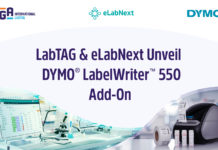
This year is the 50th anniversary of the first barcode ever scanned. The barcode’s impact is felt worldwide in almost every industry, from healthcare and research to retail and manufacturing. With an ever growing number of workflows relying on barcodes to ensure accurate and consistent identification, errors are avoided, facilities remain productive, and critical mistakes that can lead to disastrous medical outcomes are prevented. With so much depending on barcode technology, it’s worth revisiting the history of the barcode and how far it has come since its invention.
History of the barcode
The official design for the first working barcode dates back 50 years, to 1973, when the first item ever scanned using a barcode, a pack of Wrigley’s Juicy Fruit chewing gum, occurred at Marsh’s supermarket in Troy, Ohio. Technically, George Laurer, who worked for IBM to design what is currently known as the UPC barcode, staked his claim to be the “designer and developer” of the barcode, with an obituary in The Wall Stress Journal stating as much.
However, the history of the barcode dates back a little further than 1973. In 1949, Joseph Woodland filed a patent for what would ultimately become today’s barcode. Instead of straight lines, however, he used concentric circles, like a bullseye, in a pattern based on Morse code. Unfortunately, his patent was never applied, as the barcode system he had invented was impractical and unreliable. In 1967, RCA, which bought the patent from Woodland, tried to implement it in the railroad industry and at supermarkets. Unfortunately, the barcodes couldn’t be adjusted enough to make them a worthwhile investment.
An explosion of barcode types
Since the barcode was first invented, a variety of barcodes have appeared, all with their specific uses in healthcare and other industries. There are 1D, 2D, and even 3D barcodes now available to print, with different subtypes that have specific characteristics. The primary 1D barcodes used include the UPC code (primarily used in retail), Code 128, the GS1 Databar, and PDF417. When it comes to 2D barcodes, most will be familiar with the QR code, but the Data Matrix is also a popular type, especially for its ability to identify smaller items. Aztec code is another 2D barcode that is adaptable to small spaces, and its ability to be scanned even with poor resolution makes it ideal for transportation. There is even a barcode that shares some similarities with Woodland’s original design: the ShotCode, a barcode used for camera phones that’s in a circular arrangement. Color has also made it into 2D barcodes, with the High Capacity Color Barcode, the JAB Code, and the Cronto Visual Cryptogram all finding utility for specialized applications.
Novel uses for barcodes in science
Some of the newer uses for barcodes in science appeared in animals as big as zebras and as small as insects. It was known that zebra stripes are different for each animal, but it was only recently that scientists at the University of Illinois-Chicago and Princeton University decided to design a tracking method that takes full advantage of their uniqueness. Their invention, StripeSpotter, can take images and discern the patterns for each individual animal, making it a full-blown zebra strip barcode detector. And if you think barcodes couldn’t possibly be used on small animals like ants, think again; in 2018, scientists decided to stick tiny QR codes to the back of these animals to assess social behavior in response to disease spreading.
DNA barcodes are also playing a major role in ecological science. By creating databases of individual species using DNA sequences that share low intra-species variability, new species are now being discovered at a rapid pace. They’re also being used to detect invasive species, assess biodiversity, and analyze food safety. Protein barcodes have also been used in health science; with the help of CRISPR/Cas9, scientists at Mount Sinai introduced 100 unique barcode patterns into specific proteins, with antibodies generated against the epitopes to help identify the proteins’ binding partners. By doing this, they elucidated several markers for cancer immune editing.
LabTAG by GA International is a leading manufacturer of high-performance specialty labels and a supplier of identification solutions used in research and medical labs as well as healthcare institutions.



